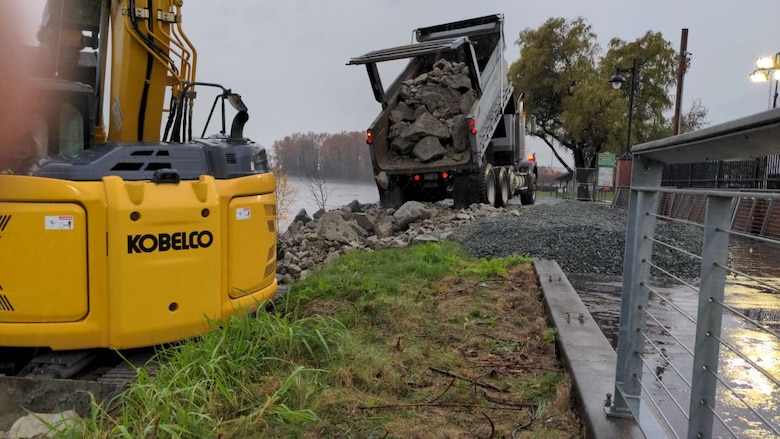The Emergency Operations Center at the Seattle District, U.S. Army Corps of Engineers extended its flood fight efforts across various counties to respond to an atmospheric river and heavy precipitation impacting the region.
According to National Oceanic and Atmospheric Administration, atmospheric rivers are long, flowing columns of condensed water vapor. Like a conveyor belt, they carry vapor for thousands of miles from out over the ocean. When an atmospheric river hits the West Coast, it can generate a series of storms, with each storm producing inches of rain. Another atmospheric river is forecasted for the region starting Saturday evening, Nov. 13 through Monday, Nov. 15.
A Corps team providing direct assistance to the City of Mount Vernon began work Nov. 11, 2021, to repair an eroding segment of a Skagit River levee near Lions Park. Crews are stabilizing the levee by placing rock armor along a 150-foot-long damaged section on the left bank of the river to mitigate against levee failure during the flood. Construction at the city is expected to be completed tonight. The levee provides protection within the City and unincorporated Skagit County to include public infrastructure, downtown Mount Vernon, residential structures, businesses, and utilities.
Two additional flood response teams deployed today to the White and Snohomish River basins. Both teams are working as river spotters, monitoring local conditions, and checking on potential vulnerable levees.
30, 000 sandbags have been delivered to Skagit County and the district is currently coordinating sandbag deliveries to various communities along the Olympic Peninsula. The district previously provided pumps to the City of Orting and Quileute Indian Nation, which they are currently using to help reduce possible high-water levels.
Engineers in the Corps’ Reservoir Control Center are monitoring conditions and are prepared to respond to forecasted flooding. The RCC manages and regulates Mud Mountain and Howard Hanson Dams, both located near Enumclaw. Both reservoirs are near empty and have storage space available to greatly reduce the risk of flooding on those rivers. They also manage Ross and Upper Baker dams in the Skagit River basin and Wynoochee dam in the Chehalis River basin when pre-defined flood flow thresholds are forecasted in those basins.
Public Law 84-99 enables the Corps to assist state and local authorities in flood fight activities and cost share in the repair of flood protection structures. The purpose is to prevent loss of life and minimize property damage associated with severe weather.
Private citizens seeking sandbags should contact their local government offices.
The National Weather Service issues flood watches and warnings and should be consulted for that information.

